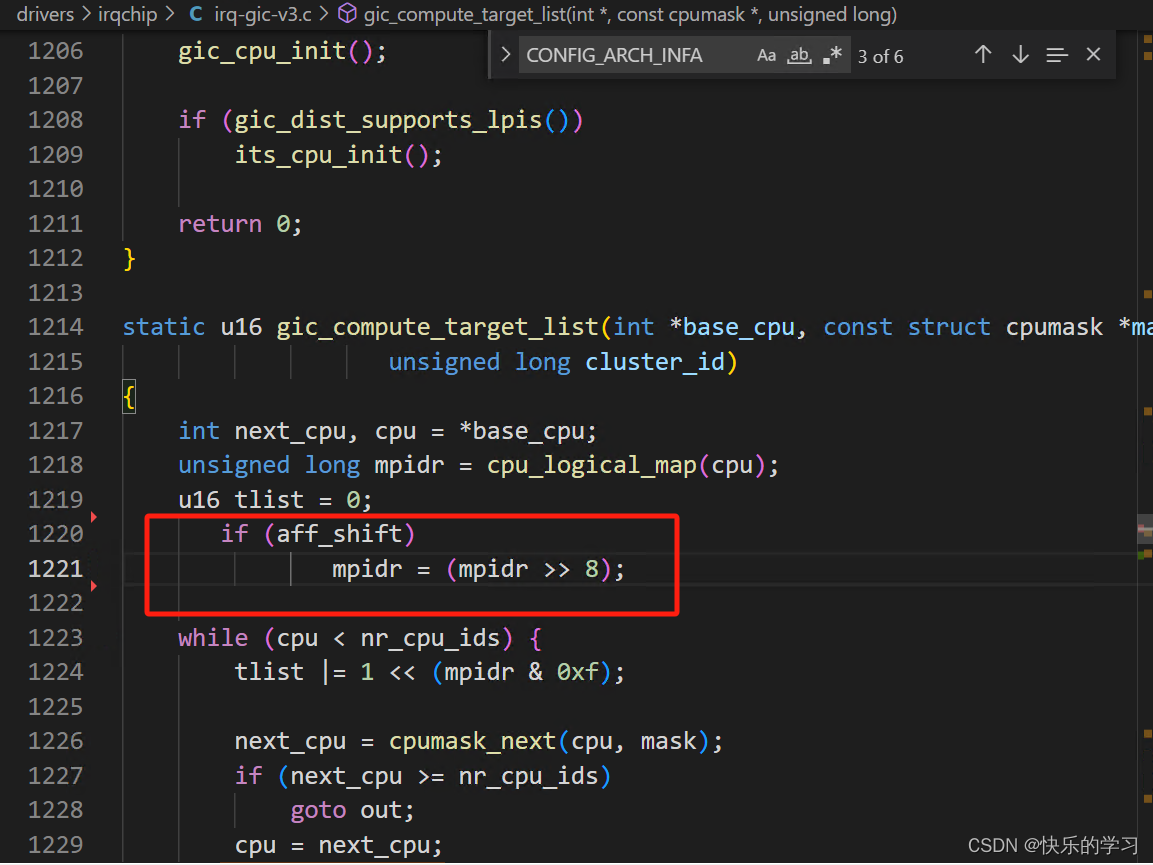目录
- 一、综述
- 二、调试流程简介
- 2.1 大体流程
- 2.2 spin-table简介
- 三、uboot和内核配置
- 3.1 uboot配置
- 3.2 timer配置
- 3.3 GIC中断配置
- 3.4 驱动确认
- 3.5 SMP配置
- 3.6 内核config配置
- 四、其他相关链接
- 1、[交叉编译linux内核总结](https://blog.csdn.net/Luckiers/article/details/124531266)
- 2、[uboot方式启动硬盘手动制作的根文件系统方案](https://blog.csdn.net/Luckiers/article/details/122476023)
- 3、[Linux下设备树dts内容总结](https://blog.csdn.net/Luckiers/article/details/124772722)
一、综述
本文主要工作中围绕ARM A55的EVB版多核启动问题进行分析,涉及到timer、gic中断模块,详细整理了整个过程。
目标机器:ARM A55 8核CPU
交叉编译环境:Ubuntu 22.04.2 LTS
内核版本:5.15.79
二、调试流程简介
2.1 大体流程
本文重点讲述内核调试过程,uboot部分讲述相关配置,本次使用spin-table方式启动多核、涉及ARM通用时钟模块,GIC500中断,整体过程如下:
1、uboot编译;
2、内核相关配置打开;
3、内核相关模块驱动确认;
4、内核编译;
5、linux系统定制;

2.2 spin-table简介
spin-table方式的多核启动方式,顾名思义在于自旋,主处理器和从处理器上电都会启动,主处理器先启动,从处理器在spin_table_secondary_jump处wfe睡眠,主处理器通过修改设备树的cpu节点的cpu-release-addr属性为spin_table_cpu_release_addr,这是从处理器的释放地址所在的地方,主处理器进入内核后,会通过smp_prepare_cpus函数调用spin-table 对应的cpu操作集的cpu_prepare方法从而在smp_spin_table_cpu_prepare函数中设置从处理器的释放地址为secondary_holding_pen这个内核函数,然后通过sev指令唤醒从处理器,从处理器继续从secondary_holding_pen开始执行(从处理器来到了内核的世界),发现secondary_holding_pen_release不是自己的处理编号,然后通过wfe继续睡眠,当主处理器完成了大多数的内核组件的初始化之后,调用smp_init来来开始真正的启动从处理器,最终调用spin-table 对应的cpu操作集的cpu_boot方法从而在smp_spin_table_cpu_boot将需要启动的处理器的编号写入secondary_holding_pen_release中,然后再次sev指令唤醒从处理器,从处理器得以继续执行(设置自己异常向量表,初始化mmu等),最终在idle线程中执行wfi睡眠。其他从处理器也是同样的方式启动起来,同样最后进入各种idle进程执行wfi睡眠,主处理器继续往下进行内核初始化,直到启动init进程,后面多个处理器都被启动起来,都可以调度进程,多进程还会被均衡到多核。
三、uboot和内核配置
3.1 uboot配置
1、配置时钟频率,影响uboot中uart时钟和启动linux内核timer时钟
#define SCFG_SYS_CLOCK 100000000

#define COUNTER_FREQUENCY 200000000 // 200 MHz generic timer clock

2、设置CPU_RELEASE_ADDR地址
该地址为DDR中一段地址即可,不可与uboot、内核加载地址重合,建议放在内存的后面部分
/* #define CPU_RELEASE_ADDR infa_slave_cores_halt */
#define CPU_RELEASE_ADDR 0x9b0000000
uboot在启动后将该值存放在X1寄存器中,后续传给内核。
该地址的作用:
芯片上电后primary cpu开始执行启动流程,而secondary cpu则将自身设置为WFE睡眠状态,并且为内核准备了一块内存,用于填写secondary cpu的入口地址。
uboot负责将这块内存的地址写入devicetree中,当内核初始化完成,需要启动secondary cpu时,就将其内核入口地址写到那块内存中,然后唤醒cpu。
secondary cpu被唤醒后,检查该内存的内容,确认内核已经向其写入了启动地址,就跳转到该地址执行启动流程。

注:因为该芯片为公司基于ARM自研的芯片,部分配置进行了定制,配置信息可参考相应修改。
3、config配置
CONFIG_ARMV8_MULTIENTRY=y
3.2 timer配置
1、修改dts
timer {compatible = "arm,armv8-timer";interrupts = <GIC_PPI 13 IRQ_TYPE_LEVEL_HIGH>,<GIC_PPI 14 IRQ_TYPE_LEVEL_HIGH>,<GIC_PPI 11 IRQ_TYPE_LEVEL_HIGH>,<GIC_PPI 10 IRQ_TYPE_LEVEL_HIGH>;};
2、确定驱动
该timer驱动为ARM通用驱动模块,中断号一般都是固定的

3.3 GIC中断配置
1、dts配置
gic: interrupt-controller@3A000000 {compatible = "arm,gic-v3";#interrupt-cells = <3>;interrupt-controller;reg = <0x0 0x3A000000 0x0 0x020000>, /* GICD */<0x0 0x3A100000 0x0 0x100000>; /* GICR */#address-cells = <2>;#size-cells = <2>;ranges;gic_its: gic-its@3A400000{compatible = "arm,gic-v3-its";reg = <0x0 0x3A020000 0x0 0x10000>;socionext,synquacer-pre-its = <0x3A400000 0x400000>;msi-controller;#msi-cells = <1>;};
注:该gic中断对应的基地址与具体芯片有关。
3.4 驱动确认

3.5 SMP配置
1、修改dts新增多核CPU配置
主要是cpu-release-addr = <0x9 0xb0000000>要与uboot下设置的值一致,同时reg = <0x0 0x0>;中通过MPIDR方式记录cpu核的id,本块板子是用MPIDR[23:8]进行记录,所以cpu1是偏移8bit从0x100开始的。

dts内容如下:
cpus {#address-cells = <2>;#size-cells = <0>;cpu0: cpu@0 {device_type = "cpu";compatible = "arm,armv8";reg = <0x0 0x0>;enable-method = "spin-table";cpu-release-addr = <0x9 0xb0000000>;next-level-cache = <&l2_cluster0>;clock-frequency = <1600000000>;};cpu1: cpu@1 {device_type = "cpu";compatible = "arm,armv8";reg = <0x0 0x100>; /*should be 0x100,0x200.....MPIDR[23:8] is ID*/enable-method = "spin-table";cpu-release-addr = <0x9 0xb0000000>; /*just used to save Secondary CPU Start Addr*/next-level-cache = <&l2_cluster0>;clock-frequency = <1600000000>;};cpu2: cpu@2 {device_type = "cpu";compatible = "arm,armv8";reg = <0x0 0x200>; /*should be 0x100,0x200.....MPIDR[23:8] is ID*/enable-method = "spin-table";cpu-release-addr = <0x9 0xb0000000>; /*just used to save Secondary CPU Start Addr*/next-level-cache = <&l2_cluster0>;clock-frequency = <1600000000>;};cpu3: cpu@3 {device_type = "cpu";compatible = "arm,armv8";reg = <0x0 0x300>;enable-method = "spin-table";cpu-release-addr = <0x9 0xb0000000>;next-level-cache = <&l2_cluster0>;clock-frequency = <1600000000>;};cpu4: cpu@4 {device_type = "cpu";compatible = "arm,armv8";reg = <0x0 0x400>; /*should be 0x100,0x200.....MPIDR[23:8] is ID*/enable-method = "spin-table";cpu-release-addr = <0x9 0xb0000000>; /*just used to save Secondary CPU Start Addr*/next-level-cache = <&l2_cluster0>;clock-frequency = <1600000000>;};cpu5: cpu@5 {device_type = "cpu";compatible = "arm,armv8";reg = <0x0 0x500>; /*should be 0x100,0x200.....MPIDR[23:8] is ID*/enable-method = "spin-table";cpu-release-addr = <0x9 0xb0000000>; /*just used to save Secondary CPU Start Addr*/next-level-cache = <&l2_cluster0>;clock-frequency = <1600000000>;};cpu6: cpu@6 {device_type = "cpu";compatible = "arm,armv8";reg = <0x0 0x600>; /*should be 0x100,0x200.....MPIDR[23:8] is ID*/enable-method = "spin-table";cpu-release-addr = <0x9 0xb0000000>; /*just used to save Secondary CPU Start Addr*/next-level-cache = <&l2_cluster0>;clock-frequency = <1600000000>;};cpu7: cpu@7 {device_type = "cpu";compatible = "arm,armv8";reg = <0x0 0x700>; /*should be 0x100,0x200.....MPIDR[23:8] is ID*/enable-method = "spin-table";cpu-release-addr = <0x9 0xb0000000>; /*just used to save Secondary CPU Start Addr*/next-level-cache = <&l2_cluster0>;clock-frequency = <1600000000>;};
3.6 内核config配置
CONFIG_SMP=y
CONFIG_NR_CPUS=8

)





)


)

:古早显卡上最新版 WebUI 安装及简单操作)






